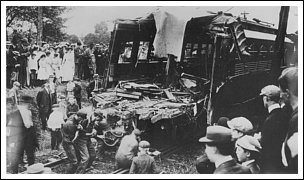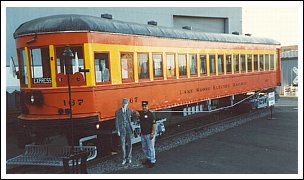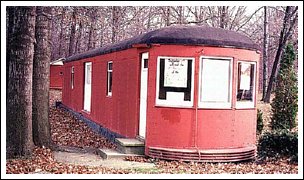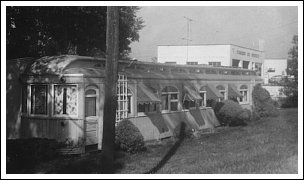
|
Just beyond the end of Liberty Ave. the Lake Shore Electric crossed Edson Creek and came to Bluebird Beach, stop 129. Originally named for the small bathing beach here, a summer cottage resort by the same name was established just to the west in the 1920's and is today a neighborhood of year-round residences. Stop 129 was also the east end of the Lake siding. From here the right-of-way curved south and ran parallel to present-day Blissful Road. This area was known as Ackerman's curve, named for the nearby Ackerman farm, and was the location of a tragic head-on collision between two interurbans in 1906. August 4th of that year was a hot and humid Saturday, a busy day for Vermilion's beaches and amusement parks. At 3:30 in the afternoon LSE 152 was westbound, behind schedule, and crowded to twice its seating capacity. Motorman Wilbur Moody had orders to stop at Lake siding to allow an eastbound car to pass. Possibly tired and distracted by the crowd, Moody apparently forgot his orders. Conductor H.W. Remlinger later testified that when he realized the car had missed the siding he attempted to alert the motorman who did not respond. He then tried to make his way through the standing crowd to pull the trolley pole from the overhead wire and stop the car. But by then 152 was rounding Ackerman's curve and the eastbound car appeared dead ahead. Both were traveling about 50 miles per hour and could not stop in the short distance. The collision killed motorman Moody and one passenger instantly. Two others would die later, and 52 more were injured. It would remain the deadliest accident in LSE history. The LSE crossed Cleveland Road at stop 130, near present day Aurora Drive in the Bluebird Beach neighborhood, then ran parallel to the New York Central railroad tracks for about 1½ miles. Along the way it passed stop 131 at Sherarts Road, later renamed Coen Road in honor of Edward Coen, who had remained an important figure in Vermilion business and civic organizations his entire life. Curiously stop 133 appears to have been in the middle of nowhere, in the woods away from roads. Tracing a line directly north, however, leads to the site of a unique campground, the Cask Villa. In 1925 a number of giant wine casks, made surplus by prohibition, were purchased from a Cleveland winery by William Cash, who owned a campground at the mouth of Darby Creek. The casks were converted to small cottages and rented to vacationers. The Lake Pointe West condominiums have suplanted the campground and cottages but the place is still known as Cask Villa. From stop 133 the LSE made a wide curve to the north, crossed Darby Creek on a concrete bridge, and rejoined Cleveland Road at the cemetery on Cuddeback (now Risden) Road, stop 134. A driveway along the edge of the cemetery is the former LSE roadbed. Stop 134½ was added nearby in the 1920's with the establishment of Orchard Beach. An 82 lot cottage neighborhood was built on the north side of Lake Road and the area's first golf course on the south side. The cottages are now permanent residences and the golf course is now the Vermilion Country Club. The Shore Inn, stop 136, was built in the early 1800's as a residence, later became an inn, and has been restored to a private residence once again. The neighborhood of Volunteer Bay, stop 137, was founded as a retreat for members of the Spanish War Veterans Association in 1922 and remains a private community today. At many stops along the railway small "waiting stations" were constructed to shelter riders from inclimate weather while they waited for the next interurban. Surprisingly some of these shelters still survive. In fact, three of them exist within a half mile stretch on Vermilion's west side. The present owners of the former Shore Inn have preserved the waiting station from that stop, now moved to the rear of the home. Another can be seen along the road (and former LSE right-of-way) in front of the Volunteer Bay neighborhood. And less than 1000 feet away the third can be seen near the road in front of the former Rumsey Park Farm, stop 138. Ghost Cars In years past Vermilion was dotted with an even more significant collection of LSE relics: the interurban cars themselves. Several of these remained in Vermilion for decades. Most have disappeared but a few lucky ones were rescued and survive today. Freight motor 38 was built in the Lake Shore's own Sandusky shops in 1920. It covered many miles, making nightly runs between Cleveland and Detroit in the 1920's. It was sold in 1939 and moved to the Vermilion Fish & Game Club where it stayed for nearly 70 years, used as an office and storage shed. In 2008 the car was aquired by Tom Patton and moved to Avon Lake where it awaits restoration. Freight motor 39 was identical to 38 and also built in Sandusky in 1920. After retirement in 1938 it was purchased by Vermilion businessman Warren "Smitty" Smith who placed it along the river for use as a boat livery and bait shop. The business name later changed to Ryser's Boat House. It was aquired by collector Ron Jedlicka in the late 1960's and moved to Homerville. Car 64 was a passenger/baggage combine built by the Brill Company in 1903. At that time it was one of the most luxurious cars on the LSE roster boasting leather seating and a separate smoking section. After a long career it was put into storage in 1932 and sold in 1938. The photo below shows it on a hillside near the river in 1939 but it disappeared shortly after and nothing is known of its fate. Car 166 was a wood combine built by the Jewett company of Newark, Ohio in 1911 specifically for the purpose of working the Cleveland to Lima service along with its sister 165. Later it was used for Cleveland to Toledo limited and express service until 1938. It was then converted to a cottage near Vermilion-on-the-Lake and survived until 1966 when it was destroyed during a poorly executed attempt to move it. Steel passenger car 174 was built by the Jewett company of Newark, Ohio in 1918. In 1939 its body was moved to West River Road and converted to a residence where it remained well preserved until 1996. It was then moved to The Works, a museum in the old Jewett factory building in Newark where it has been restored and put on display. Steel Jewett 167, which made the very last LSE passenger run in 1938, was moved to the Ackerman farm, near the site of the deadly 1906 wreck, where it was converted to a cottage along with 181. In 1964 car 167 was purchased by Dennis and Richard Lamont who moved it to Westlake and began a lengthy restoration. It has been displayed at various events such as the Lorain steel mill's centennial celebration in 1996 and is still owned by Dennis Lamont today. 181 was moved to the Northern Ohio Railway Museum near Chippewa Lake in 1979 where it presently awaits restoration. |

Creek west of downtown. (Dennis Lamont) |

Edson Creek and stop 129 are in the background. (Tom Bailey) |
|

railfans snap photos. (Franklyn P. Kellogg photo) |
|

Beach subdivision. (Ralph A. Perkin photo) |
|

west of Lake siding. (John A. Rehor) |
|

surprisingly low. (Dennis Lamont) |
|

the accident scene. (Dennis Lamont) |
|

morning following the accident. (Dennis Lamont) |
|

(Vermilion Views) |

crossing near Bluebird Beach. (Dennis Lamont) |

directly north of the remote stop 133. (Vermilion Views) |

of the LSE bridge at Darby Creek. (Drew Penfield photo) |

follows LSE right-of-way. (Dennis Lamont photo) |

area and is now the Vermilion Country Club. (Dennis Lamont) |

private residence. (Vermilion Views) |

residence that was the Shore Inn. (Dennis Lamont) |

showing the path of the LSE. (Vermilion Views) |

Volunteer Bay. (Drew Penfield photo) |

(Drew Penfield photo) |

Park farmhouse in the background. (Drew Penfield photo) |

rainy day circa 1940. (Pearl Roscoe photo) |

spent 25 years as cottages. (Dennis Lamont) |

Lorain in 1996. (Dennis Lamont) |

(Dennis Lamont photo) |

and Game Club. (Vermilion Views) |

until being moved after the 1969 flood. (Vermilion Views) |

in 1939. It disappeared shortly after. (Vermilion Views) |

year before it was destroyed. (Tom Bailey photo) |

was purchased for restoration in 1996. (Dennis Lamont photo) |

city where it was built in 1918. (www.attheworks.org) |
|
|
|